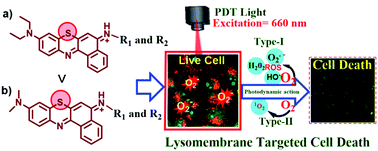NIR-excited superoxide radical procreators to eradicate tumors by targeting the lyso-membrane†
Abstract
NIR photosensitizers have been used as potential photo-activators to inhibit cancer cells as well as the growth of various types of bacteria. Herein, we first designed NIR alkylated cationic photosensitizers (Et-NB-C12 > Et-NB-C18 and Mt-NB-C12 > Mt-NB-C18), which target the lyso-membrane for the eradication of tumor cells through prominent superoxide radical generation (type-I PDT) via the lysosome disruption pathway. The O2−˙ radical sensors (DHE and DHR123) exhibited a 10-fold increment in fluorescence intensity in solution and MCF-7 cells after treatment with NIR cationic photosensitizers under 660 nm irradiation. Et-NB-C12 > Et-NB-C18 preferentially targeted the lyso-membrane, resulting in O2−˙ radical generation in the lyso-membranes during PDT irradiation. Furthermore, lysosomal disruption, flow cytometry, and MTT assays demonstrated that the influential generation of O2−˙ radicals in cancer cells initiated cell apoptosis and further cell death after irradiation with PDT light at 660 nm. The inhibition activity of Et-NB-C12 > Et-NB-C18 in MCF-7 cells showed stronger anticancer efficiency (IC50 0.08 > 0.12 μM) than that of Mt-NB-C12 > Mt-NB-C18 (IC50 = 0.30 > 0.32 μM), lower than that of Ce6 (1.28 μM). In particular, Et-NB-C12 can be effectively utilized in in vivo imaging, and it exhibits outstanding anticancer properties during both ex vivo and in vivo photodynamic therapy.



 Please wait while we load your content...
Please wait while we load your content...